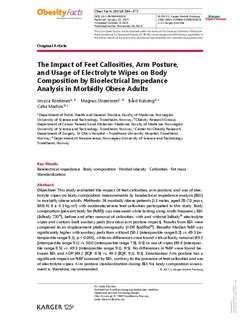The Impact of Feet Callosities, Arm Posture, and Usage of Electrolyte Wipes on Body Composition by Bioelectrical Impedance Analysis in Morbidly Obese Adults
Journal article, Peer reviewed
Permanent lenke
http://hdl.handle.net/11250/2368292Utgivelsesdato
2015Metadata
Vis full innførselSamlinger
Sammendrag
Objective: This study evaluated the impact of feet callosities, arm posture, and use of electrolyte wipes on body composition measurements by bioelectrical impedance analysis (BIA) in morbidly obese adults. Methods: 36 morbidly obese patients (13 males, aged 28-70 years, BMI 41.6 ± 4.3 kg/m2) with moderate/severe feet callosities participated in this study. Body composition (percent body fat (%BF)) was measured while fasting using multi-frequency BIA (InBody 720®), before and after removal of callosities, with and without InBody® electrolyte wipes and custom-built auxiliary pads (to assess arm posture impact). Results from BIA were compared to air displacement plethysmography (ADP, BodPod®). Results: Median %BF was significantly higher with auxiliary pads than without (50.1 (interquartile range 8.2) vs. 49.3 (interquartile range 9.1); p < 0.001), while no differences were found with callosity removal (49.3 (interquartile range 9.1) vs. 50.0 (interquartile range 7.9); NS) or use of wipes (49.6 (interquartile range 8.5) vs. 49.3 (interquartile range 9.1); NS). No differences in %BF were found between BIA and ADP (49.1 (IQR: 8.9) vs. 49.3 (IQR: 9.1); NS). Conclusion: Arm posture has a significant impact on %BF assessed by BIA, contrary to the presence of feet callosities and use of electrolyte wipes. Arm posture standardization during BIA for body composition assessment is, therefore, recommended.
